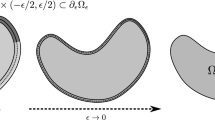Abstract.
When standard boundary element methods (BEM) are used in order to solve the linearized vector Molodensky problem we are confronted with two problems: (1) the absence of O(|x|−2) terms in the decay condition is not taken into account, since the single-layer ansatz, which is commonly used as representation of the disturbing potential, is of the order O(|x|−1) as x→∞. This implies that the standard theory of Galerkin BEM is not applicable since the injectivity of the integral operator fails; (2) the N×N stiffness matrix is dense, with N typically of the order 105. Without fast algorithms, which provide suitable approximations to the stiffness matrix by a sparse one with O(N(logN)s), s≥0, non-zero elements, high-resolution global gravity field recovery is not feasible. Solutions to both problems are proposed. (1) A proper variational formulation taking the decay condition into account is based on some closed subspace of co-dimension 3 of the space of square integrable functions on the boundary surface. Instead of imposing the constraints directly on the boundary element trial space, they are incorporated into a variational formulation by penalization with a Lagrange multiplier. The conforming discretization yields an augmented linear system of equations of dimension N+3×N+3. The penalty term guarantees the well-posedness of the problem, and gives precise information about the incompatibility of the data. (2) Since the upper left submatrix of dimension N×N of the augmented system is the stiffness matrix of the standard BEM, the approach allows all techniques to be used to generate sparse approximations to the stiffness matrix, such as wavelets, fast multipole methods, panel clustering etc., without any modification. A combination of panel clustering and fast multipole method is used in order to solve the augmented linear system of equations in O(N) operations. The method is based on an approximation of the kernel function of the integral operator by a degenerate kernel in the far field, which is provided by a multipole expansion of the kernel function. Numerical experiments show that the fast algorithm is superior to the standard BEM algorithm in terms of CPU time by about three orders of magnitude for N=65 538 unknowns. Similar holds for the storage requirements. About 30 iterations are necessary in order to solve the linear system of equations using the generalized minimum residual method (GMRES). The number of iterations is almost independent of the number of unknowns, which indicates good conditioning of the system matrix.
Similar content being viewed by others
Author information
Authors and Affiliations
Additional information
Received: 16 October 1999 / Accepted: 28 February 2001
Rights and permissions
About this article
Cite this article
Klees, R., van Gelderen, M., Lage, C. et al. Fast numerical solution of the linearized Molodensky problem. Journal of Geodesy 75, 349–362 (2001). https://doi.org/10.1007/s001900100183
Issue Date:
DOI: https://doi.org/10.1007/s001900100183




